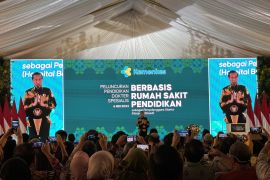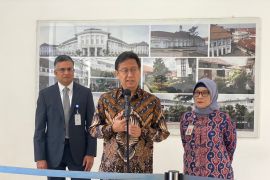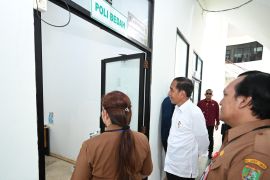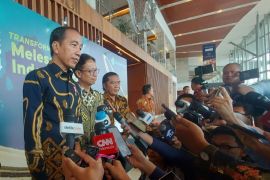The policy is aimed at accelerating the fulfillment of the need for 124,294 general practitioners and 29,179 specialist doctors starting in 2024.
Indonesia, with a population of around 275 million, needs to pursue a doctor-population ratio of one per 1,000 population and a specialist doctor-population ratio of 0.28 per 1,000 population.
"I read this morning that our doctor population ratio is still at 0.47 per 1,000 (population)," President Joko Widodo (Jokowi) stated at the program's launch event in Jakarta.
With that ratio, Indonesia is currently ranked 147th in the world and 9th in the ASEAN.
The Ministry of Health noted that the number of general practitioners in Indonesia is only 156,310 doctors out of an average of around 12 thousand graduates per year from 117 medical schools.
The number of specialist doctors in Indonesia has reached 49,670 people, with an average of 2,700 specialist doctor graduates per year from 24 medical schools. However, 59 percent of them are concentrated on Java island.
The president underscored the need for breakthroughs to tackle the issue of shortages of doctors and specialist doctors in Indonesia, including driving 24 medical schools and 420 government hospitals to produce more doctors.
The Teaching Hospital-Based Specialist Doctor Education Program is expected to serve as an alternative for meeting the country's need for doctors and specialist doctors apart from university-based programs.
Hence, the Ministry of Health is reminded that state spending invested in sophisticated medical equipment worth trillions of rupiah should not be wasted due to the absence of operators among doctors and specialist doctors.
The Indonesian Chamber of Commerce and Industry (Kadin) stated that expenditure for the procurement of medical equipment for the next four to five years at the Indonesian Ministry of Health reached Rp60 trillion (around US$3.72 billion), obtained from loans from four world banking institutions.
Those institutions are World Bank, Asian Development Bank (ADB), Asian Infrastructure Investment Bank (AIIB), and Islamic Development Bank (ISDB).
The medical equipment spending is intended to meet the needs for handling cancer, heart disease, stroke, uro-nephrology services, and maternal and child health.
In the initial stage of the program, there are six specialty programs in six main teaching hospitals, namely ophthalmology, cardiology, pediatric, neurology, orthopedic, and oncology specialties.
The Ministry of Health is facilitating 38 participants to take part in the six specialty programs, comprising six participants in the cardiology program at Harapan Kita Heart and Blood Vessel Hospital and six participants in the pediatric program at Harapan Kita Mother and Child Hospital.
The ministry has also provided a quota of 10 people for the orthopedic and traumatology program at the Soeharso Orthopedic Hospital.
The rest are six participants at the Cicendo Eye Hospital, five participants at the neurology program at the National Brain Center Hospital, and six participants of the radiation oncology program at the Dharmais Cancer Hospital.
The specialty program participants will learn by working under the guidance of senior specialist doctors at the teaching hospitals.
Throughout the education period, the organizers waive all educational fees. The participants are treated like interns in the hospitals, entitled to incentives, health insurance protection, and legal protection.
In the next stage of the Teaching Hospital-Based Specialist Doctor Education Program development, the ministry will involve private hospitals to facilitate priority specialty programs, which means that government hospitals will not be the only ones used for the program.
Health Minister Budi Gunadi Sadikin expressed optimism that the program would tackle the problem of unequal distribution of doctors that has not been resolved for 79 years.
Currently, with only 2,700 graduates per year, it will take more than a decade to meet the need for specialist doctors. Meanwhile, the program can expedite the fulfillment of the need for specialist doctors, from 10 years to around five years.
International standards
Some groups have raised concerns that hospital-based specialist doctor education could produce health workers who are not up to the standard and put at risk the health of people being served.
Minister Sadikin emphasized that medical residents, who are participants in the program, are not ordinary medical students but rather doctors who have met competency standards according to their level of education.
In terms of quality, specialist doctors trained in the program are believed to be on par with specialist doctors graduating from other specialist medical programs around the world.
To meet these quality standards, the Ministry of Health is involving all collegiums in Indonesia and abroad, as well as the Accreditation Council for Graduate Medical Education (ACGME).
Accelerating the production of doctors and specialist doctors in Indonesia is an urgent need ahead of the demographic dividend in the next 10-15 years when 68 percent of Indonesia's population will be of the working age.
To this end, the Teaching Hospital-Based Specialist Doctor Education Program is present as the key to tackling the shortage and unequal distribution of medical personnel in the country.
Related news: Jokowi underscores need for more specialist doctors from universities
Related news: Ministry introduces programs to address specialist doctor shortage
Translator: Andi Firdaus, Raka Adji
Editor: Tia Mutiasari
Copyright © ANTARA 2024












